Harvey's Harvest includes over 8 acres of cultivated land and thousands of trees. The front field, on 166th Ave E, boasts the entire variety of trees that grow on our farm.
What varieties do we have? We have Turkish (Nordman) Fir, Grand Fir, Douglas Fir, Colorado Blue Spruce, and Scotch (Scots) Pines.
Below you will find extensive descriptions of the Christmas tree varieties as taken from various reference sources on the web. The pictures included below are stock photographs from the webpages referenced and in many cases do not accurately reflect the methods we use to culture our trees. You will find pictures of our trees on the farm tour page (with video) or you can use our quick reference guide.
Turkish (or Nordmann) Fir
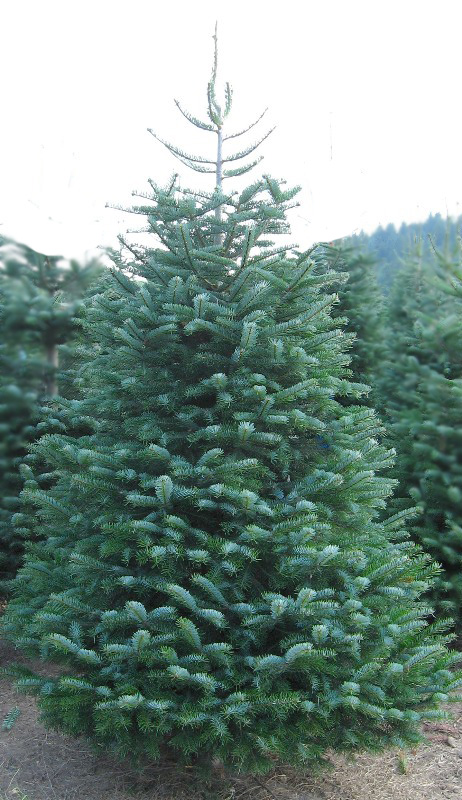
Abies nordmanniana subsp. equi-trojani
Description:
Nordmann Fir (Abies nordmanniana) is a fir native to the mountains south and east of the Black Sea, in Turkey, Georgia, Russian Caucasus and northern parts of Armenia. It occurs at altitudes of 900-2,200 m on mountains with a rainfall of over 1,000 mm.
It is a large evergreen coniferous tree growing to 60 m tall and with a trunk diameter of up to 2 m. In the Western Caucasus Reserve, some specimens have been reported to be 78 m and even 85 m tall, the tallest trees in Europe.
The leaves are needle-like, flattened, 1.8-3.5 cm long and 2 mm wide by 0.5 mm thick, glossy dark green above, and with two blue-white bands of stomata below. The tip of the leaf is usually blunt, often slightly notched at the tip, but can be pointed, particularly on strong-growing shoots on young trees. The cones are 10-20 cm long and 4-5 cm broad, with about 150-200 scales, each scale with an exerted bract and two winged seeds; they disintegrate when mature to release the seeds.
There are two subspecies (treated as distinct species by some botanists), intergrading where they meet in northern Turkey at about 36°E longitude:
Caucasian Fir Abies nordmanniana subsp. nordmanniana. Native to the Caucasus mountains and northeastern Turkey west to about 36°E. Shoots often pubescent (hairy).
Turkish Fir Abies nordmanniana subsp. equi-trojani (syn. A. bornmuelleriana, A. equi-trojani). Native to northwestern Turkey from Mount Ida eastwards to about 36°E. Shoots usually glabrous (hairless).
The species is named after Alexander von Nordmann (1803-1866), Professor of Botany at Odessa.
Nordmann Fir is one of the most important species grown for Christmas trees, being favored for its attractive foliage, with needles that are not sharp, and do not drop readily when the tree dries out.
It is also a popular ornamental tree in parks and large gardens.
The wood is soft and white, and is used for general construction, paper, etc.
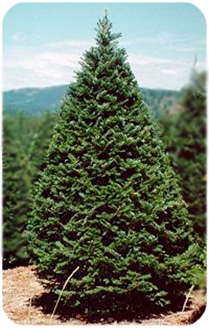 Grand Fir
Grand Fir
Abies grandis (Dougl. ex D. Don) Lindl.
Description:
The grand fir is one of the tallest firs, reaching heights of 300 feet. It is easily distinguished from other Pacific Northwest firs by its sprays of lustrous needles in two distinct rows. They are usually horizontally spread so that both the upper and lower sides of the branches are clearly visible. The needles are 1 to 1 1/2 inches long with glossy dark green tops and two highly visible white lines of stomata on the undersides.
The pollen strobili are yellowish and the cones are yellowish-green to green, cylindrical, erect, 2 to 4 inches long, occur high in the crowns and dissipate in the fall to release their seeds.
The bark is grayish-brown, usually with white mottles, smooth with resin blisters when young, becoming rigid and then scaly with age. Like most other true firs, it is thinned barked and therefore very sensitive to fire. Control of fires in the drier southern parts of the northwest has allowed a widespread increase of grand fir over the last 50 years.
Range:
It grows from British Columbia inland to Montana and south into northern California. It grows in dry to moist coniferous forests in rain shadow areas, often in association with Douglas-fir. It commonly ranges from river flats to fairly dry slopes from low to middle elevations.
Propagation:
Past research has identified the "Panhandle" area of Idaho as a desirable seed source. Most seedlings produced for Christmas tree growers originate from this region. It is germinated from seed in both greenhouses and bare root nurseries and usually transplanted in a nursery for one to two years.
Uses:
It is a minor Christmas tree species throughout Washington and Oregon, but a major species in the inland states of Idaho and Montana. It produces a beautiful, thick foliaged tree when sheared and is known for its strong fragrance. In most areas, it will produce a marketable tree in eight to ten years.
Grand fir and white fir are softwoods with characteristics so similar that they are used interchangeably. They are moderately strong and light weight. Earlywood is creamy white to light brown while the latewood gradually changes to reddish brown or a lavender tinge. The heartwood is indistinct.
The wood is relatively straight grained and easy to work. It is most often sold as White Wood, Hem-Fir (Hemlock-Fir) or ES-AF-LP (includes Engelmann spruce, alpine fir and lodgepole pine) for construction. It is also used for boxes, decoration and utility. It has excellent resistance to splitting in nailing and screwing and has outstanding gluing qualities.
Folklore:
Northwest native Americans have a history of making uses of grand fir foliage and branches. Kwakwaka'wakw shamans wove its branches into headdresses and costumes and used the branches for scrubbing individuals in purification rites. The Hesquiat tribes used its branches as incense and decorative clothing for wolf dancers.
It was occasionally used as a fuel. Some interior tribes such as the Okanogan, also made canoes from its bark. Pitch was applied to bows for a secure grip and rubbed on paddles and scorched for a good finish. A brown dye from its bark was used in making baskets by the Straits Salish tribe, along with a pink dye made by mixing the brown dye with red ochre. Knots were shaped, steamed and carved into halibut hooks by several coastal tribes.
Grand fir bark, sometimes mixed with stinging nettles, was boiled and the concoction used for bathing and as a general tonic. The Lushoot tribe boiled needles to make a medicinal tea for colds. The Ditidaht sometimes brought boughs inside as a air freshener and burned them as an incense and to make a purifying smoke to ward off illnesses. These people also crushed and mixed the bark of grand fir, red alder and western hemlock and made an infusion that was rank for internal injuries. The Hesquiat mixed the pitch of young trees with oil and rubbed it on the scalp as a deodorant and to prevent balding.
Prepared by Dennis Tompkins, Editor of the "American Christmas Tree Journal"
Douglas Fir
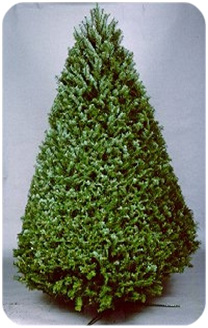
Pseudotsuga menziesii (Mirb.) Franco
Description:
Douglas-fir is not related to the true firs.
This wide ranging species grows from 70 to 250 feet tall. The branches are spreading to drooping, the buds sharply pointed and the bark is very thick, fluted, ridged, rough and dark brown.
The needles are dark green or blue green, 1 to 1 1/2 inches long, soft to the touch and radiate out in all directions from the branch. They have a sweet fragrance when crushed.
Pollen strobili are small and reddish-brown. Young cones are small, oval shaped and hang downward. They are reddish-brown to gray, 3" long and do not dissipate to spread seed as do true firs (Abies sp.). The cones open in the late summer to disperse the seeds and will continue to hang on the trees through the fall.
Range:
The entire range includes central California, western Oregon and Washington, parts of the Rockies and extends north to Alaska. It grows under a wide variety of environments from extremely dry, low elevation sites to moist sites.
On the west side of the Cascades and Sierra Nevada, it is often the predominate species, but usually occurs in conjunction with several other confers. On the coasts, it is associated with western hemlock and other conifers.
Bigcone Douglas-fir (P. macrocarpa), the other Pseudotsuga species in western North America, has a very restricted range limited to Southern California and Baja, Mexico. It is not used as a Christmas tree.
Under natural conditions, Douglas-fir has established primarily after fires on wetter sites. The trees can live for a thousand years, largely due to a very thick bark that allows them to survive moderate fires. Thus many ancient old-growth forests contain large Douglas-fir that represent the legacy of fires that occurred many centuries ago.
Propagation:
Seed is generally germinated in bare root nurseries and increasingly in container nurseries. It is usually sold as a two or three year old transplant.
Research has been done on grafting and rooting from cuttings. The practicality of these techniques has yet to be proven and remains more of a curiosity rather than a new trend to produce seedlings from trees that exhibit superior Christmas tree characteristics.
Uses:
The Douglas-fir has been the major Christmas tree species used in the Pacific Northwest since the 1920's. During the following 40 years, nearly all trees were harvested from forest lands. Since the 1950's, the transformation from growing trees in the wild to culturing them on plantations has been dramatic. Today, few trees come from forest lands.
An interior strain from the Rocky Mountains (P. menziesii var. glauca) has been extensively planted throughout several midwestern state Christmas tree plantations. It is preferred because of its ability to withstand the more harsh growing conditions than the Pacific Northwest seed sources.
Nationally, it remains one of the most popular Christmas trees species. It is shipped to the majority of the states and is also exported to the Hawaiian Islands, Guam and some Asian markets.
Plantation trees are normally sheared and will produce a crop within 7 to over 10 years depending upon the site and growing area.
Douglas-fir is one of the stronger of the softwoods and is widely used for structural purposes. The sapwood is white to pale yellow while the heartwood is orange-red with high contrast between earlywood and latewood.
It is straight grained and moderately hard. It is used widely in construction, laminated timbers, plywood and high grade veneer, interior trim, cabinet work, pallets, boxes, ladders and flooring.
It is also one of the more common softwoods used in export markets.
Prepared by Dennis Tompkins, Editor of the "American Christmas Tree Journal"
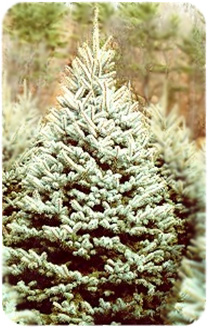
Colorado Blue Spruce
Picea pungens Engelm.
Description:
Colorado blue spruce, or blue spruce, is an attractive tree often used for Christmas trees or as ornamentals, particularly in the eastern United States and Europe. It is the official state tree of both Colorado and Utah. The species generally reaches a height of 65-115 feet at maturity with a diameter of 2-3 feet. It has a narrow, pyramidal shape and cone-shaped crown. As trees become older, they often take on a more irregular appearance. While blue spruce grows relatively slowly, it is long-lived and may reach ages of 600-800 years.
Leaves (needles) are 1-1 1/2 inches long on lower branches but somewhat shorter on upper branches. They are 4-sided and have a very sharp point on the end. It is this point which gives the species its name "pungens", from the Latin word for sharp as in puncture wound. Needles are generally dull bluish-gray to silvery blue and emit a resinous odor when crushed. Some trees have a more distinct bluish-white or silvery-white foliage. The cultivated variety 'glauca' is noted for this type of coloration. Nursery managers also select for "shiners" which demonstrate this very desirable characteristic. Needles occur on small peg-like structures on the twig called sterigmata. The sterigmata persist on the twigs after needles have fallen, which is usually after the third or fourth year.
Both male and female flowers (strobili) occur in the same tree, although in different locations. Pollination occurs in late spring and cones mature in one season. In the fall, cones are 2-4 inches long and turn chestnut brown with stiff, flattened scales. Cones generally persist on the tree for one to two years after seed fall.
The bark is thin becoming moderately thick with age. It is somewhat pale gray in small flattened scales when young, then turns reddish brown and furrowed with age.
Blue spruce is moderately shade tolerant and grows best in deep, rich, gravely soils, often along stream banks and other sites with high moisture levels. It usually does not occur in large stands but is found in small groves or in association with Douglas-fir, lodgepole pine, Engelmann spruce or ponderosa pine. A deep penetrating root system makes the species resistant to being blown over.
Major pests include the western spruce dwarf mistletoe, spruce bark beetle, and spruce budworm. Trees infected with mistletoe typically develop abnormal masses of branches called "witches brooms". With severe infestations, trees may be killed.
Blue spruce is finding increasing popularity as a Christmas tree as a result of its symmetrical form and attractive blue foliage. The species has an excellent natural shape and requires little shearing. Additionally, needle retention is among the best for the spruces. Its popularity as an ornamental leads many consumers to use blue spruce as a living Christmas tree, to be planted after the holiday season.
Range:
Blue spruce occurs naturally from western Wyoming and eastern Idaho southward through central Colorado and Central Utah. The southern limits are New Mexico and Arizona. It occurs at elevations of 6,000 to 11,000 feet; generally at higher elevations in the more southern areas.
Propagation:
Most propagation is by seed but blue spruce can be grafted or grown from rooted cuttings. Vegetative propagation is more often used to perpetuate the rarer, more desirable forms of the species. Picea abies or Picea pungens are preferred rootstock for grafting.
Over 70 cultivated varieties have been named.
Uses:
The wood is light to pale brown in color and is lightweight, soft, and brittle. The lack of natural pruning leads to boards often being full of knots. Blue spruce grows in relatively inaccessible locations leading to its not being commercially important as a timber species. The wood is suitable, however, for posts, poles, and fuel.
Blue spruce has limited value to wildlife but does provide cover and seeds for squirrels, rodents and some birds.
In the western United States, the species has found some use in shelterbelts.
Prepared by Dr. Craig R. McKinley, North Carolina State University
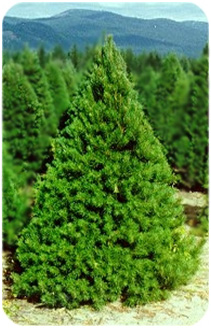
Scotch (Scots) Pine
Pinus sylvestris L.
Description:
Scotch or Scots pine is an introduced species which has been widely planted for the purpose of producing Christmas trees. It is an extremely hardy species which is adaptable to a wide variety of soils and sites. As a Christmas tree, it is known for its dark green foliage and stiff branches which are well suited for decorating with both light and heavy ornaments. It has excellent needle retention characteristics and holds up well throughout harvest, shipping and display.
The needles of Scotch pine are produced in bundles of two. They are variable in length, ranging from slightly over 1-inch for some varieties to nearly 3-inches for others. Color is likewise variable with bright green characteristic of a few varieties to dark green to bluish tones more prominent in others. The undersides of Scotch pine needles are characterized by several prominent rows of white appearing stomatal openings.
The bark of upper branches on larger, more mature trees displays a prominent reddish-orange color which is very distinctive and attractive. Large amounts of cones are likewise produced which often persist on the tree from one year to the next. Like most pines two growing seasons are required to produce mature cones. On excellent sites within its native range mature trees may reach a trunk diameter of 30 inches or more and individual trees may exceed 125 feet in height.
Range:
Scotch pine is native to Europe and Asia. From the British isles and Scandinavian peninsulas through central Europe south to the Mediterranean and east through eastern Siberia, Scotch pine can be found at varying elevations.Scotch pine was introduced to North America by European settlers and has long been cultivated, especially in the eastern United States and Canada. It is adaptable to a wide variety of sites and accordingly, has been widely planted for both Christmas tree and ornamental purposes. Although plantations have been established in the United States for the purpose of producing forest products, the species does not perform as well as in its native habitat.
Propagation:
Scotch pine is reproduced from seed. More than thirty five different seed sources or varieties are commercially recognized. Seed is obtained by international collectors and marketed through reputable seed dealers. A few seed orchards have been established in the United States from which seed is locally collected. For Christmas tree production purposes seed is usually sown in the spring and the resulting seedlings are allowed to grow for two years in the nursery bed before they are lifted and sold to Christmas tree producers. There has been some research by university personnel to identify and produce genetically improved planting stock, although these efforts have not been totally successful.
Uses:
In Europe and throughout several countries in Asia, Scotch pine is an important species of high economic value. Forest stands containing Scotch pine are managed to produce pulpwood, poles, and sawlogs from which dimension and finish lumber is produced. Logs from trees of large diameters are processed into veneer and used in manufacturing plywood. The species is also valued as an ornamental and landscape plant and has been widely planted in parks and gardens.
As a Christmas tree Scotch pine is probably the most commonly used species in the United States. Because of its ease of planting, generally high planting survival and favorable response to plantation culture it has been widely planted throughout much of the eastern United States and Canada. For several years it was the favorite species of large eastern wholesale growers because of its excellent harvesting and shipping qualities. It is also a preferred species for many choose and cut growers in much of the eastern and central United States.
When established in plantations usually 6 to 8 years are required to produce a 7 to 8 foot tree. The tree requires annual shearing, usually beginning the second or third year following planting and continuing on through the year of harvest. Scotch pine is host to a number of insect and disease problems, and continued protection from foliage and stem damaging agents is necessary. The species is not demanding with respect to fertility or moisture and supplemental fertilization or irrigation is not considered necessary.
As a Christmas tree Scotch pine is known for its excellent needle retention and good keepability. It resists drying and if permitted to become dry does not drop its needles. When displayed in a water filled container it will remain fresh for the normal 3 to 4 week Christmas season. Like all natural trees it is readily recyclable and has many different uses following the Christmas holidays.
Prepared by Dr. Melvin R. Koelling, Michigan State University